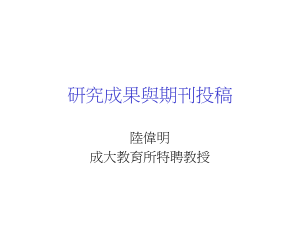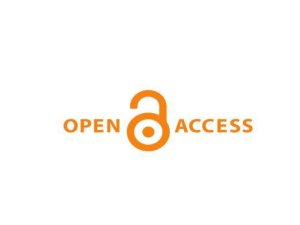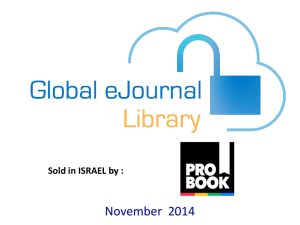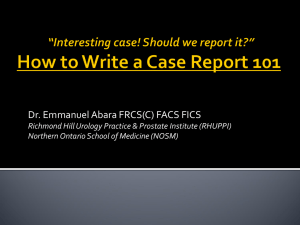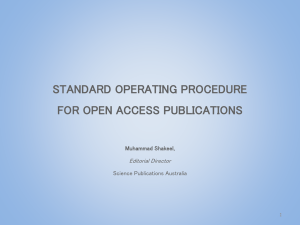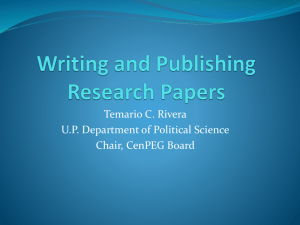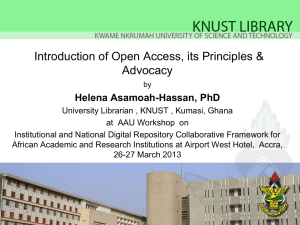Open - The ScholarShip at ECU
advertisement
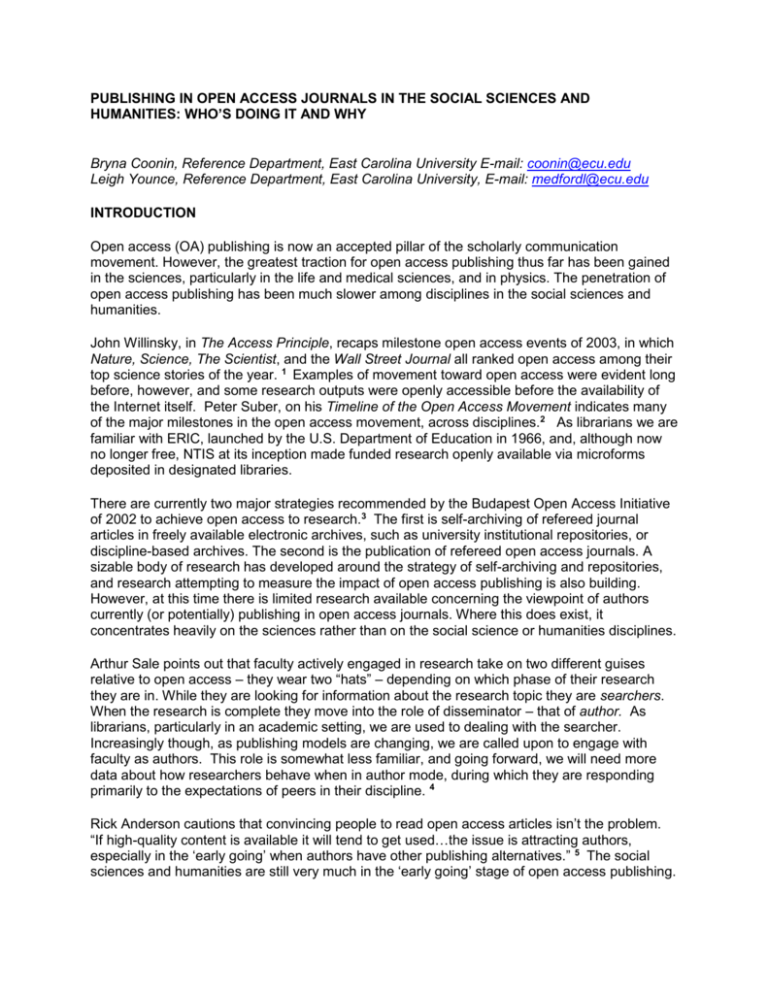
PUBLISHING IN OPEN ACCESS JOURNALS IN THE SOCIAL SCIENCES AND HUMANITIES: WHO’S DOING IT AND WHY Bryna Coonin, Reference Department, East Carolina University E-mail: coonin@ecu.edu Leigh Younce, Reference Department, East Carolina University, E-mail: medfordl@ecu.edu INTRODUCTION Open access (OA) publishing is now an accepted pillar of the scholarly communication movement. However, the greatest traction for open access publishing thus far has been gained in the sciences, particularly in the life and medical sciences, and in physics. The penetration of open access publishing has been much slower among disciplines in the social sciences and humanities. John Willinsky, in The Access Principle, recaps milestone open access events of 2003, in which Nature, Science, The Scientist, and the Wall Street Journal all ranked open access among their top science stories of the year. 1 Examples of movement toward open access were evident long before, however, and some research outputs were openly accessible before the availability of the Internet itself. Peter Suber, on his Timeline of the Open Access Movement indicates many of the major milestones in the open access movement, across disciplines.2 As librarians we are familiar with ERIC, launched by the U.S. Department of Education in 1966, and, although now no longer free, NTIS at its inception made funded research openly available via microforms deposited in designated libraries. There are currently two major strategies recommended by the Budapest Open Access Initiative of 2002 to achieve open access to research.3 The first is self-archiving of refereed journal articles in freely available electronic archives, such as university institutional repositories, or discipline-based archives. The second is the publication of refereed open access journals. A sizable body of research has developed around the strategy of self-archiving and repositories, and research attempting to measure the impact of open access publishing is also building. However, at this time there is limited research available concerning the viewpoint of authors currently (or potentially) publishing in open access journals. Where this does exist, it concentrates heavily on the sciences rather than on the social science or humanities disciplines. Arthur Sale points out that faculty actively engaged in research take on two different guises relative to open access – they wear two “hats” – depending on which phase of their research they are in. While they are looking for information about the research topic they are searchers. When the research is complete they move into the role of disseminator – that of author. As librarians, particularly in an academic setting, we are used to dealing with the searcher. Increasingly though, as publishing models are changing, we are called upon to engage with faculty as authors. This role is somewhat less familiar, and going forward, we will need more data about how researchers behave when in author mode, during which they are responding primarily to the expectations of peers in their discipline. 4 Rick Anderson cautions that convincing people to read open access articles isn’t the problem. “If high-quality content is available it will tend to get used…the issue is attracting authors, especially in the ‘early going’ when authors have other publishing alternatives.” 5 The social sciences and humanities are still very much in the ‘early going’ stage of open access publishing. Thus, it may be unclear to many authors in these disciplines whether OA is at the edge of a viable publishing trend, or on the fringe of it. RELEVANT LITERATURE Nicholas and Rowlands point out that, as of 2003/2004, the discussion surrounding open access took into account viewpoints of open access advocacy groups, publishers, and librarians, “…but what was largely missing were the views of the authors, arguably the most important stakeholder group.” 6 In 2004, U.K. authors Alma Swan and Sheridan Brown, on behalf of the Joint Information Systems Committee (JISC) and the Open Society Institute (OSI), surveyed 154 authors who published in open access journals and 157 who had not. 7 Swan and Brown investigated authors’ awareness of open access, and their experiences of publishing their work as OA. Swan and Brown also explored authors’ concerns about the implications open access publishing may have for their careers, and the reasons why (or not) they chose to publish through an open access outlet. Among their findings was a very high percentage (90%) of open access authors who said their primary reason for choosing an open access journal was the principle of free access to research information. The non-OA group believed that open access journals were of lower reputation and prestige. Both groups had some concerns that publishing in an open access journal would affect their chance of winning research grants. (It should be noted that the Wellcome Trust’s initial position statement strongly endorsing open access was published only very shortly before, in October 2003.) 8 The Swan and Brown survey included authors internationally and across a number of disciplines, but numbered only a very small selection of authors in the social sciences and humanities. David Nicholas, Paul Huntington, and Ian Rowlands sought to determine well-established authors’ attitudes toward OA publishing.9 Surveying nearly 4,000 senior authors from 97 countries, this was the largest author survey conducted concerning OA publishing. One of the most striking findings to emerge from this study was the general ignorance of OA publishing among the senior authors surveyed. In addition, real differences of opinion and practice emerged among authors of different disciplines. Like Swan and Brown, however, the disciplines covered were largely concentrated in the sciences, with a very small percentage of respondents from the social sciences and humanities. METHODOLOGY This study surveyed 918 authors from 2007-2008 issues of open access journals in psychology, business management, women’s studies, and music. Journal titles selected were taken from the Directory of Open Access Journals (DOAJ), all had ISSN numbers, all were fully open access according the strictures established by DOAJ (all content is freely available with free user registration an acceptable option and no embargo period). All were journals that report primary results of research or overviews of research results to the scholarly community. All were in English and published in the United States. All were peer-reviewed. The URL for the web-based survey, delivered via SurveyMonkey, was e-mailed to the authors in October 2008. The survey closed on November 6, 2008. See Appendix. FINDINGS AND DISCUSSION A total of 339 surveys were returned, for an overall response rate of 36.9 percent. The total number of respondents varies slightly by question. Small discrepancies in figures are the result of rounding. Figure 1: Respondents by Discipline Other 8.50% n=339 Women's Studies 8.1% Music 7.1% Psychology 58.1% Business 23.1% The DOAJ’s journal subject categories were used to differentiate among the four disciplines – psychology, business, music, women’s studies. ”Other” represents respondents who, although they published in these OA journals, primarily identified with other disciplines, such as sociology, criminal justice, or health. See Figure 1 above. Age and academic status Of the 338 respondents to this question 18% were between 18-30 years old, 29.9% were 31-40 years old, 22.5% were 41-50 years old, 21.9% were age 51-60, and 12.7% were 61 years or above. Of these 50.6% were tenured, 21.0% were tenure-track, 6.6% non-tenure Track, 9.9% were graduate students, 2.4% were retired/emeritus, 9.6% were “other,” including six post-docs, with the remaining a mixture of clinicians, independent scholars, adjunct/contact instructors, or individuals working in institutions that do not have a tenure system. Important factors in deciding where to publish Overall, respondents attached the greatest importance (96.7%) to peer-review of the journal. The reputation of the journal (90.2%) and the suitability (“match”) of the manuscript to the journal (90.2%) were both considered next in importance. The quality of the editor/editorial board followed (74.4%), indicating perhaps that peer-review alone, while of fundamental importance, was not sufficient. To many, it also mattered who the peers were that were involved in the review process. See Figure 2. Figure 2: Decision Factors in Where to Publish by Discipline Psychology Business Music Women's Studies Published there before Good match Copyright retention Grant-awarding body Scholarly Society Timeliness Acceptance rate Editorial board Peer review Citation impact Reputation 100% 90% 80% 70% 60% 50% 40% 30% 20% 10% 0% Timeliness of publication (67.6%), citation ‘impact’ (55.3%), and acceptance rate (40%) followed in relative importance. Least important were the influence of the grant-awarding body (6.3%) and the ability to retain copyright (16.9%). The relatively low importance attached to the issue of copyright retention is significant because it means that the existing publishing model is fairly entrenched. Attempts to encourage scholars to retain their rights may be greeted with a lukewarm response. Self-archiving Nicholas found that those making available scholarly materials on their own web page or depositing in an institutional archive were about one and a half times more likely to publish in OA journals.10 Our findings differed from Nicholas on this. Of 335 respondents to this question, 37.0% replied that they had self-archived either on a personal or departmental web page, or in an institutional or subject-related archive; 63.0% said they had not. Electronic vs. print -- does it matter? Of the 329 total respondents to this question 40.7% responded that electronic journals were acceptable; 0.6% said they were not acceptable; 36.2% responded that they were “less desirable than print”; 22.5% said this is not an Issue – that ‘other’ factors more important. Notably, this overall response is reflected fairly evenly across the four disciplines surveyed. See Figure 3. Figure 3: Acceptability of Electronic Journals by Discipline Psychology n=180 Business n=83 Music n=22 Women's Studies n=25 60% 48 50% 40.3 40% 40.9 38.1 37.8 35.4 36.4 28 30% 21.6 24 25.6 18.2 20% 10% 4.5 0 0% Acceptable 1.2 0 Not Acceptable Less Desirable Than Print Not an issue From several responses in the “General Comments” section at the end of the survey it was evident that some scholars think of the terms ‘open access’ and ‘electronic’ journals synonymously rather than fully understanding open access as a publishing model, not just a format change. Importance of publication type for advancement in the discipline Respondents uniformly indicated that publication in peer-review journals was most highly valued for tenure, promotion, and advancement. Of note is the regard for trade journals reported by business respondents. See Figure 4. Figure 4: Importance of Publication Type by Discipline Psychology Business Music Women's Studies Performances Compositions or arrangements Textbooks Case Studies Pre-prints/Working papers Abstracts Presentations at professional meetings Conference Proceedings Articles in Trade Journals Peer Reviewed Journal Articles Book Reviews Books/Monographs 100% 90% 80% 70% 60% 50% 40% 30% 20% 10% 0% Psychology, business, and women’s studies valued books/monographs next. The high importance attributed to books is significant because these are far less likely to become open access items. The publishing environment for books is very different from journal publishing and books, unlike journal articles, may provide royalties to the author. Of interest, though, is the California Institute of Technology Library’s CalTechBOOK repository, which has successfully cornered some faculty tomes.11 Article Output -- how prolific overall, and how many were OA? Of the 329 total respondents, 3.3% published one article; 17.6% published 2-5 articles; 16.7% published 5-10 articles; 19.5% published 10-20 articles; 42.9% published more than 20. Of the 330 total respondents to the question of how many of their output were OA, 40.9% published 1 article in OA journals; 39.1% published 2-5 in OA journals; 5.5% published 5-10 in OA journals; 2.4% have published 10 – 20 in OA journals; 1.5% published more than 20 this way; and 10.6% of the respondents did not know how many were OA. Nicholas and Rowlands found that prolific authors were more likely to publish in open access journals.12 Our findings echo this assertion. Noteworthy is that 76.3% of the prolific authors (‘prolific’ here defined as publishing 10 or more articles) responding to our survey were tenured. Awareness of open access publishing Of the 325 respondents, 39.4% were “Very Aware”; 43.4% were “Somewhat Aware”; 17.2% were “Not at all Aware.” See Figure 5. Figure 5: Awareness of Open Access by Age Very Aware Somewhat Aware Not At All Aware 60% 50% 40% 30% 20% 10% 0% Under 30 yrs n=44 31-40 yrs n=101 41-50 yrs n=76 51-60 yrs n=74 Over 60 yrs n=43 Nicholas and Rowlands found older authors were more likely to report knowing nothing at all about open access. 13 Our findings belie this somewhat. When asked how they became aware of open access publishing, 318 responded. Of these 14.5% said, “this is the first I’ve heard of it,” indicating that they had published in an OA journal without being conscious of its being OA. The largest percentage (43.4%) reported becoming aware of OA publishing from colleagues, 39.3% became aware while searching the Internet for publishing opportunities, 33.3% heard about OA via their professional societies; 11.6% said their institution made them aware of it, and 8.5% specified that their institution’s library made them aware. Perceptions of Open Access Publishing In discussing open access publishing with faculty it can be helpful to have an idea of how open access is perceived by them. See Figure 6. Figure 6: Perceptions of Open Access Publishing n=327 OA means free access for all readers TRUE FALSE No opinion 89.9% 5.2% 4.9% OA journals have faster publication times 65.7% 18.7% 15.6% Readership will be larger 47.2% 26.9% 25.9% Articles will be more frequently cited 20.6% 40.6% 38.8% OA publishing will help reduce cost of publication subscriptions 73.5% 8.3% 18.2% OA journals are less prestigious than subscription based journals 46.5% 30.6% 22.9% OA journals will not be properly archived 7.1% 62.2% 30.8% OA journals may adversely affect the viability of scholarly societies 8.0% 63.3% 28.7% May adversely affect chances at promotion 11.1% 62.7% 26.2% OA journals are usually not peer reviewed 3.4% 76.9% 19.8% Exploring further the perception of whether OA journals are “less prestigious than subscription based journals,” we found that among authors age 61 year or more, 52.4% said true (OA is less prestigious) and 21.4% said false. Of those aged 51-60, 43.7% said true (OA is less prestigious) and 33.8% said false. Younger authors were a bit more forgiving. Of our authors under 30, 32.5% said true (OA is less prestigious); 47.5% said false. The age of a journal (while not the sole determinant) can certainly be a factor in whether it is considered to be prestigious. Rick Anderson makes the point that many OA journals just do not yet have the long publication history necessary to build the reputation that a journal such as Nature (which began publishing in 1869) enjoys.14 Author Publication Fees Open access means free to the reader, but not necessarily free for the publisher producing the journal. The ‘author pays’ model is fairly well accepted in the sciences, where grant money routinely takes care of the fees. For many in the social sciences and humanities, however, this may be a less acceptable model, whether because research is often undertaken without substantial grant funding, or because (to some) it may sound a bit too close to “vanity press” publishing. Of the 323 respondents 26.9% said they have published in journals that had author fees. Of these, 54% were in psychology, 35.6% were in business, zero in music, 3.44% in women’s studies. Six respondents skipped this question. Of those who published in journals that used the “author pays” model, 31% said a funding agency paid the fee. More than half (57%) who had funding agency assistance with this were in psychology, 24% were from business, with music and women’s studies each reporting at 9.9%. Of the 323 respondents to this question 42.1% reported that they would not do ‘author pays.’ Rick Anderson points out that in a mixed publishing economy, where OA and non-OA publishing opportunities exist, given the choice between publishing in an OA journal at a substantial cost and an equally prestigious journal at no personal cost, an author would have to be powerfully motivated by the moral argument or by an external mandate of some kind. He also emphasizes that the shift means the author (not the publisher) takes responsibility for securing the necessary funding. 15 This scenario may represent a somewhat different “cultural norm” for many in the social science and humanities disciplines. ‘Author pays’ in an open access setting, however (as distinct from ‘author pays’ in a subscription journal), means that the author is making the research available to everyone, not just to a subscriber base. It is of interest that the Directory of Open Access Journals (http://www.doaj.org), in its “For Authors” section, offers a search option allowing authors to distinguish between ‘no publication fee’ and ‘publication fee.’ Here authors can readily distinguish between OA titles that ask a fee from the author’s side and those that do not. CONCLUSIONS Peer review and peer acceptance is at the heart of scholarly research endeavors. The data suggest that peer-review will remain key to the decision of where to publish, regardless of the business model used for publishing. There also exists some confusion over the terms “electronic” publishing and “open access” publishing. In discussing open access publishing with faculty, it may be important to establish that the concept of open access is not the same as a format change from print to electronic. The culture of the discipline has some bearing on this discussion. Psychology, for example, is a fairly concise discipline with a scholarly journal publishing history dating back to the 1800’s, although it should be noted that the American Psychological Association is now including in PsycINFO quality peer-reviewed open access journals that meet the APA’s requirements for indexing.16 Women's Studies, on the other hand, is interdisciplinary and still relatively young. It evolved out of the politics of its time: the Vietnam War protests, Women's Liberation, the Civil Rights movement, and the struggle for gay and lesbian rights. Marilyn Boxer states, "from the beginning, the goal of women's studies was not merely to study women's position in the world but to change it." 17 Women/gender studies attracts a wide variety of authors including medical doctors, gender activists, poets and artists, free-lance researchers, and even humanitarian workers who may be as interested (or more interested) in getting their research out than in seeking tenure. Increasingly, open access represents a leading edge in scholarly publishing, rather than the “fringe.” However, an understanding (and acceptance) of open access journal publishing as a viable outlet for scholarly publishing is still quite dependent on the research and publishing culture within the disciplines. For authors working in the non-science disciplines especially, open access may take a while to reach fuller acceptance, if it does. More discipline-related research is needed concerning open access publishing in the social sciences and humanities, among both OA and non-OA authors. NOTES 1. John Willinsky. The Access Principle: the Case for Open Access to Research and Scholarship. Cambridge, MA: MIT Press, 2006: 1. 2. Peter Suber. Timeline of the Open Access Movement (formerly called the Timeline of the Free Online Scholarship Movement) http://www.earlham.edu/~peters/fos/timeline.htm . 3. Budapest Open Access Initiative (2002). http://www.soros.org/openaccess/read/shtml . 4. Arthur Sale. “Researchers and Institutional Repositories,” In Open Access: Key Strategic, Technical and Economic Aspects, edited by Neil Jacobs. Oxford: Chandos, 2006: 87-98. 5. Rick Anderson, “Author Disincentives and Open Access,” Serials Review 30, no. 4 (2004): 289. 6. David Nicholas and Ian Rowlands, “Open Access Publishing: The Evidence From the Authors,” Journal of Academic Librarianship 31, no. 3 (2005): 179. 7. Alma Swan and Sheridan Brown (Key Perspectives, Ltd.), “Joint Information Systems Committee (JISC) and the Open Society Institute (OSI) Journal Authors Survey Report,” (2004) http://www.jisc.ac.uk/media/documents/themes/infoenvironment/acf655.pdf . 8. Peter Suber. Timeline of the Open Access Movement (formerly called the Timeline of the Free Online Scholarship Movement) http://www.earlham.edu/~peters/fos/timeline.htm . 9. David Nicholas, Paul Huntington, and Ian Rowlands, “Open Access Journal Publishing: the Views of Some of the World’s Senior Authors,” Journal of Documentation 61, no. 4 (2005): 497-519. 10. Ibid., 505. 11. California Institute of Technology. CalTechBOOKs. http://caltechbook.library.caltech.edu/ . 12. Nicholas and Rowlands, “Open Access Publishing: The Evidence From the Authors,” 180. 13. Ibid.,179. 14. Rick Anderson, “Author Disincentives and Open Access,” 290. 15. Ibid., 289. 16. American Psychological Association, “Open Access Journal Coverage in PsycINFO,” PsycINFO News (Fall 2007): 4. 17. Marilyn Boxer. When Women Ask Questions: Creating Women's Studies in America. Washington, DC: John's Hopkins University Press, 2001: 13. APPENDIX AUTHOR SURVEY: OPEN ACCESS SOCIAL SCIENCES and HUMANITIES JOURNALS 1. Your Age in Years: 18 – 30 31 – 40 41 – 50 51 – 60 61+ 2. Please tell us if you are currently: Tenured Tenure track Non-Tenure track Graduate Student Retired/Emeritus Other (please specify) 3. How important are the following in your decision on where to publish journal articles? Not Important 1 2 Neutral 3 4 Very Important 5 Reputation of Journal Citation impact (ex. ISI impact factor) Journal is Peer reviewed Quality of Editor/editorial board Acceptance Rate Timeliness of publication process Published by scholarly society or association Influenced by my grant-awarding body Ability to retain copyright to your work My manuscript is a good match for the journal I’ve published there before 4. Have you self-archived any of your publications (on a personal website, an institutional repository, e-print archive, etc.)? Yes No 5. In your discipline, publication in electronic journals of any kind is: Acceptable Not Acceptable Less desirable than print Not an issue - other factors are more important (e.g., prestige of journal) 6. Please indicate the importance of the following publications for tenure/promotion/advancement in your discipline: Not Important 1 2 Neutral 3 4 Very Important 5 Books/Monographs Book Reviews Peer Reviewed Journal Articles Articles in Trade Journals Conference Proceedings Presentations at professional meetings Abstracts Pre-prints/Working papers Case Studies Textbooks Compositions or arrangements Performances 7. How many articles have you published in your scholarly career thus far? 1 2-5 5-10 10-20 More than 20 8. How many articles have you published in open access journals (here defined as 'freely accessible online'): 1 2-5 5-10 10-20 More than 20 Don't know how many were open access 9. When you published your article in an open access journal, how aware were you of the concept of open access publishing? Very aware Somewhat aware Not at all aware 10. How did you become aware of open access publishing? Please check all that apply. This is the first I’ve heard of it My institution My institution’s Library Funding agency Colleague Professional Society Internet searching (e.g., Google) for publishing opportunities 11. Please respond to these perceptions of open access (OA) publishing. True False No Opinion OA means free access for all readers OA journals have faster publication times Readership will be larger Articles will be more frequently cited OA publishing will help reduce cost of publication subscriptions OA journals are less prestigious than subscription based journals OA journals will not be properly archived OA journals may adversely affect the viability of scholarly societies May adversely affect chances at promotion OA journals are usually not Peer Reviewed 12. Some (both OA and non-OA) journals, in the sciences particularly, require author publication fees. I have published in a journal that required author fees I would do it if a funding agency or institution paid for it I would not publish in a journal that requires publication fees 13. Of the choices below, which of these disciplines most closely represents your area of research? Psychology Business Music Women’s/Gender Studies (e.g. women's health, activism, arts) 14. Your additional comments are welcome. )
